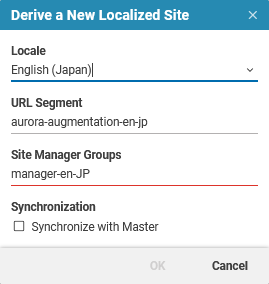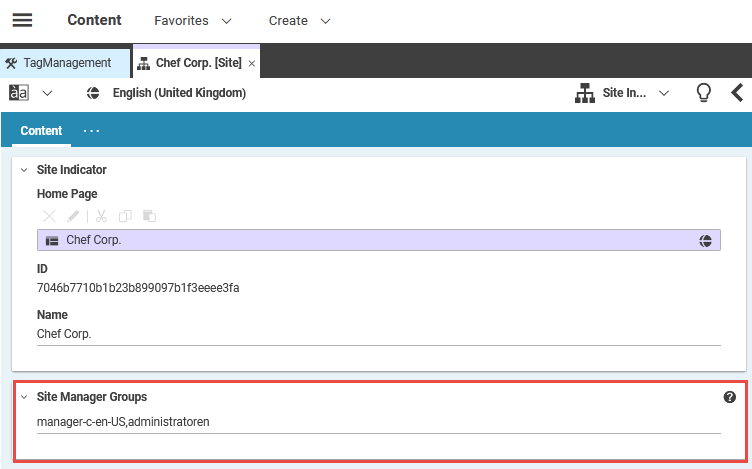Blueprint Developer Manual / Version 2412.0
Table Of Contents
This chapter describes all groups and users, that have to be defined for localization. There are
several explicit groups and one user, that can be configured in the SiteModel - see
also Section 5.5.3.1, “Site Model and Sites Service”. For an overview of predefined editorial users
that come with CoreMedia Blueprint have a look at Reference - Predefined Users.
The translation manager role is defined once in the property translationManagerRole
of the SiteModel. It is a required group for every user that needs to start a
localization workflow and to derive a site.
In case, you do not want to allow every translation manager to also derive sites, it is advisable to create an additional global site manager group, that has the right, to make modifications in the global sites folder.
Members of a site manager group take care of the contents of one or more sites. They may for example accept translation workflows if they manage the corresponding target site of a workflow. Or they may start a localization workflow (be it synchronization or translation) from the master site. For the latter, they must also be member of the translation manager role group, which is described above.

Difference for Translation and Synchronization
Despite the required translation manager role, as stated above, a user must also be assigned as a site manager group member to some site.
For both, synchronization and translation, it is enough, if the user is denoted as manager of the master site. Both types of localization workflows offer each a different alternative to this:
For translation workflows, users may alternatively also be set as site managers of all target sites of the workflow.
For synchronization workflows, users may alternatively also be set as site managers in any of the master sites up in the hierarchy.
The site manager groups can be defined in the site indicator. The name of
the corresponding property field is defined in the
siteManagerGroupProperty of the
SiteModel. Alternatives to this may be applied on
application configuration level. By default, alternative members who may
manage a site, must be member of the built-in group
administratoren (group-identifier 0 (zero)). Also by
default (other strategies may be defined) alternative members are taken
into account, when none of the specified groups exist or if the
corresponding property in the site indicators is empty.
For corresponding configuration options, see
Section 5.5.3.1, “Site Model and Sites Service”.
You may enter multiple groups separated by a comma by default. The separator is configured in
groupPropertyDelimitingRegEx of the SiteModel.
There are two ways to set the site manager group:
While deriving a new site in the sites window, you can set the group.
Directly in the site manager group property of the site indicator.
For technical reasons the actual changes during a localization workflow are performed as the
translation workflow robot user as configured in the property
translationWorkflowRobotUser of the SiteModel. The user needs read and
write access on the sites taking part in a localization workflow. As this user is only technical,
access to the editor service should be restricted, which can be done in the file
jaas.conf in the module
content-management-server-blueprint-config. (For details see
Section 3.12.1.1, “LoginModule Configuration in jaas.conf” in Content Server Manual).
Additionally, the username should be added to the property userchanges.excluded-user-names of the
User Changes Application to prevent superfluous generation of My Edited Content.
Overview of required users and groups for multi-site
Table 5.19, “Suggested Users and Groups for multi-site” shows an example, how the configuration of user groups may look like in CoreMedia Blueprint.
| Type | Name | Member of | Rights | Remark |
|---|---|---|---|---|
| group | global-site-manager | approver-role, publisher-role, translation-manager-role |
| |
| group | local-site-manager | approver-role, publisher-role, translation-manager-role |
| |
| group | manager-<language-tag> | local-site-manager |
|
Suggested pattern configured in siteManagerGroupPattern of the
SiteModel
|
| group | translation-manager-role |
Configured in translationManagerRole of the SiteModel
| ||
| group | translation-workflow-robots |
|
Group for automatic multi-site actions like translation or synchronization. This group requires supervise permissions in order to assign rights to newly created sites (deriving sites, see Section 5.6.3, “Deriving Sites”). Approve rights are required for localization processing, not for publishing to Master Live Servers. So, publish permissions are not required for this group. | |
| user | translation-workflow-robot | translation-workflow-robots |
Configured in translationWorkflowRobotUser of the SiteModel
|
Table 5.19. Suggested Users and Groups for multi-site
The rights abbreviations denote:
R - read
M - modify / edit
D - delete
A - approve
P - publish
F - folder
S - supervise
For further information about the rights, please refer to Section 3.15.2, “User Rights Management” in Content Server Manual.
Definition while deriving site
When deriving a new site, a proposal for the name of the site manager group is generated from a
predefined pattern. By default, the name starts with manager
followed by the language tag of the selected target locale (see also
Figure 5.29, “Derive Site: Setting site manager group”). This pattern may be configured in the
property siteManagerGroupPattern of the SiteModel.
Adapting site manager group later on
If the site already exists, the names of site manager groups can be set or modified directly in the site indicator (see Figure 5.30, “Site Indicator: Setting site manager group”).
If any of the given groups does not exist, the property field will be marked red and the creation of the site or the assignment of the group may not be performed, thus the groups need to have been created before. Read more about users, groups and administration in Section 3.15, “User Administration” in Content Server Manual.





